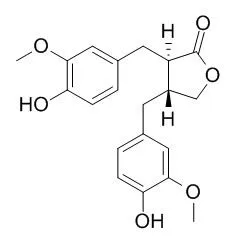Matairesinol is a plant lignan present in a wide variety of foodstuffs such as seeds, vegetables and fruits. It has various biological functions including anti-angiogenic, anti-cancer and anti-fungal activities, but its anti-osteoporotic activity, if any, is unknown.
METHODS AND RESULTS:
For osteoclast differentiation, primary mouse bone marrow-derived macrophage cells (BMMs) were cultured for 4 days in the presence of RANKL and M-CSF with the vehicle (DMSO) or Matairesinol. Cell cytotoxicity was examined by CCK-8 assay. Gene expression of NFATc1, TRAP, OSCAR, v-ATPasev0d2 were observed in the presence or absence of Matairesinol (10 μM) for the indicated times. For evaluating the involvement of NFATc1 in the anti-osteoclastogenic action of Matairesinol, BMMs were infected with pMX-IRES-GFP or pMX-IRES-CA-NFATc1-GFP for 8 h with polybrene, and then infected BMMs were cultured with M-CSF and RANKL for 4 days in the presence or absence of Matairesinol (10 μM). MAPK signaling activation was examined by immunoblotting. For measuring the resorptive activity of mature osteoclasts, osteoclasts and osteoblasts were co-cultured on BioCoat Osteologic MultiTest slides, and treated with Matairesinol for 24 h. Here we show that Matairesinol dose-dependently inhibited the RANKL-induced differentiation of BMMs into osteoclasts by downregulating RANKL-induced expression and activity of NFATc1. Ectopic overexpression of NFATc1 blunted the anti-osteoclastogenic effect of Matairesinol implicating NFATc1 in the action of Matairesinol. Additionally, Matairesinol blocked the RANKL-induced activation of p38 and ERK in BMMs, but had no effect on bone resorption activity in mature osteoclasts.
CONCLUSIONS:
Taken together, our results suggest that the anti-osteoporotic activity of Matairesinol could arise from its anti-osteoclastogenic potential via p38/ERK-NFATc1 signaling, but not by way of anti-resorptive action. |






 Cell. 2018 Jan 11;172(1-2):249-261.e12. doi: 10.1016/j.cell.2017.12.019.IF=36.216(2019)
Cell. 2018 Jan 11;172(1-2):249-261.e12. doi: 10.1016/j.cell.2017.12.019.IF=36.216(2019) Cell Metab. 2020 Mar 3;31(3):534-548.e5. doi: 10.1016/j.cmet.2020.01.002.IF=22.415(2019)
Cell Metab. 2020 Mar 3;31(3):534-548.e5. doi: 10.1016/j.cmet.2020.01.002.IF=22.415(2019) Mol Cell. 2017 Nov 16;68(4):673-685.e6. doi: 10.1016/j.molcel.2017.10.022.IF=14.548(2019)
Mol Cell. 2017 Nov 16;68(4):673-685.e6. doi: 10.1016/j.molcel.2017.10.022.IF=14.548(2019)